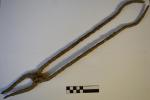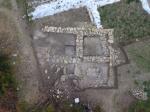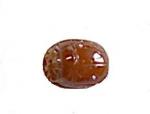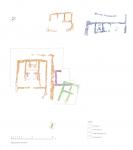Summary (English)
The 2018 campaign continued the excavation of the Aerarium of the East Sanctuary, in the area of the pronaos and the rooms of the structure situated in the south-eastern part of the temple.
The investigations on the south-western side of the pronaos of the Aerarium revealed a stone structure on a SW-NE alignment, interpretable as the base of a monument of which a few fragments of worked fossiliferous limestone were recovered. The base was covered by layers formed by the temple roof collapse and included a cippus made of tufaceous stone. These elements indicate that the structure was built before the end of the 3rd century B.C., and was coeval with the occupation phases of the oikos (4th – 3rd century B.C.) identified below the Aerarium.The area explored on the south-eastern side of the temple confirmed the presence of a structure formed by four rooms (building LF), which extended beyond the trench edge to the NE-SW. The excavation of room A (partially explored in 2017) revealed a floor surface made of crushed stone. Underneath this floor there was layer containing black glaze pottery, including some miniature forms, associated with numerous animal bones, and a second layer with fragments of tiles and ridge tiles. These levels covered a section of wall, aligned S-N, from an earlier structure visible to the south-west, in a section of wall already uncovered in previous seasons. The alignment and size of this second building will be clarified by the continuation of excavation towards the east. For the moment, the material finds suggest an occupation phase dating to at least the 4th century B.C.
More details regarding building LF emerged from the excavation of room B. The excavated stratigraphy related to the intentional deposition of objects placed on a surface of flat tiles. Among the pottery were fragments of black glaze ware associated with cooking-ware jars and lids. Numerous iron objects were present, such as knives, skewers and two pairs of metalworker’s tongs/pliers. The tile surface was uneven and overlay a level of ash and charcoal, in turn covering a stone slab floor. The latter, very patchy, was on a gravel make-up (also found in room A). There was a hearth obliterated by a complete tile (71 × 48 cm) at the centre of the stone slab floor.
This deposition of materials can be associated with the closing ritual of the room, similar to that seen in room A in 2017. The cooking and consumption of food is associated with the positioning of the ceramic objects (used for the banquet and often upside down or containing bone remains). Other objects such as miniature vases and jewellery (including a cornelian scarab, part of a seal ring), were also positioned, together with materials like the metalworking pliers, which may indicate the original use of the structure.
The construction of the Aerarium obliterated the entire eastern area with a fill positioned to the north-west of building LF. A preliminary study of the finds from the fill, compared with those intentionally placed inside rooms A and B, dates this intervention to the final decades of the 3rd century B.C. The new structure therefore belonged to a phase preceding the fill, in concomitance with the use of the oikos. The two pairs of metalworking tongs/pliers and other objects, such as a bronze support broken into pieces ready for smelting could confirm the suggestion that it was a forge. The presence of a metalworking installation close to the temple is documented by examples such as room N in building gamma at the emporion of Gravisca, situated north-east of the sanctuary of Aphrodite.
To conclude, three occupation phases were identified in the eastern area of the Aerarium. The first, corresponded with the structure below building LF, contemporary with the construction of the oikos (4th century B.C.); the second was the probable forge (building LF), datable to the final decades of the 4th century B.C. Lastly, the obliteration of the structure with the closing ritual occurring in the final decades of the 3rd century B.C., in conjunction with the temple’s construction after the Hannibalic destruction, which would also have involved the new building.
- Palma D’Amico- Istituto Nazionale di Archeologia e Storia dell’Arte
Director
- Adriano La Regina
Team
- Anna Dionisio-Istituto Nazionale di Archeologia e Storia dell’Arte
- Chiara Casale
- Sara Polvere
- Studio Artes srl, Roma
- Magdy Tawfik
Research Body
- Istituto Nazionale di Archeologia e Storia dell'Arte
Funding Body
- Comune di Pietrabbondante






![Download [PDF]](/excavation/skins/fasti/images/results/download_sml.png)


